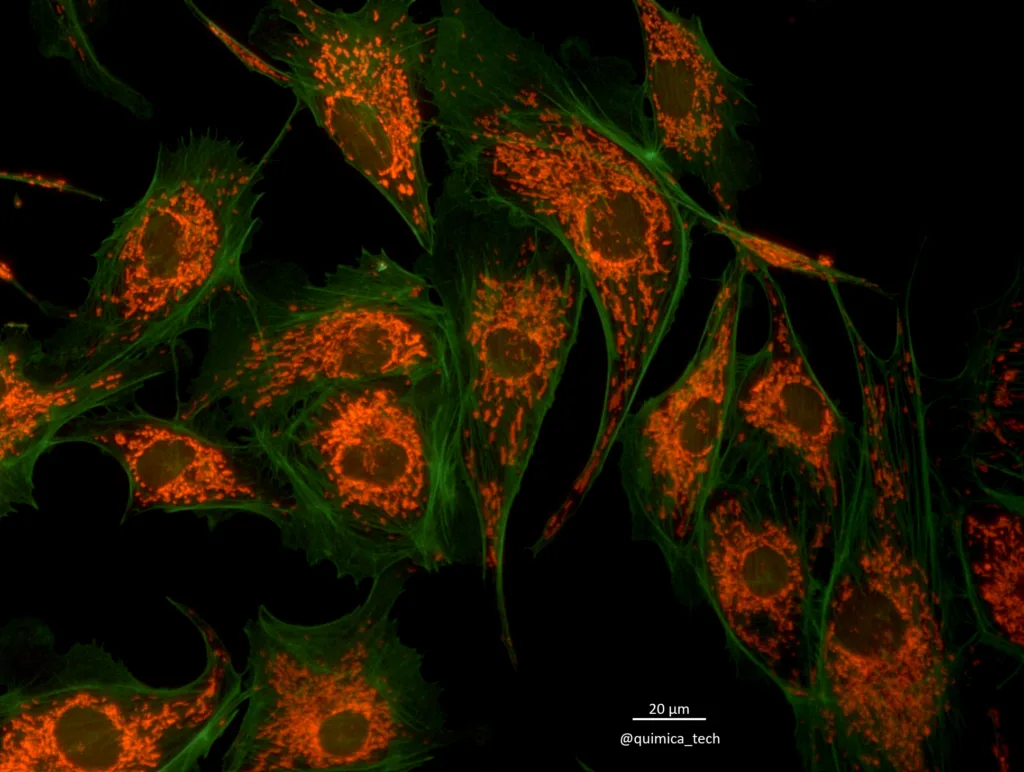In the dynamic world of fluorescence imaging, researchers and experts are constantly seeking innovative tools to enhance the precision and clarity of their experiments. One such tool that has garnered attention for its exceptional performance is the Alexa Fluor 546 dye.
In this blog post, we’ll explore the advantages that make Alexa Fluor 546 stand out and describe the diverse realms of scientific research where its brilliance succeeds.
Where to commonly used Alexa fluor 546 dye
Alexa Fluor 546 is commonly used in a variety of biological and imaging applications due to its favorable optical properties and versatility. Here are some common applications where Alexa Fluor 546 is frequently employed.
Fluorescence Microscopy
Alexa Fluor 546 is widely used in fluorescence microscopy for cellular and subcellular imaging. It is often used to label cellular structures, organelles, or specific proteins within cells.
Immunofluorescence Staining
Researchers use Alexa Fluor 546-conjugated antibodies to visualize and study the localization of specific proteins in tissues or cultured cells through immunofluorescence staining.
Flow Cytometry
In flow cytometry, Alexa Fluor 546 is used as a fluorochrome for the detection and quantification of cellular markers. It is commonly used in multicolor flow cytometry experiments.
Live Cell Imaging
The photostability of Alexa Fluor 546 makes it suitable for live cell imaging applications. Researchers use it to track dynamic cellular processes over time.
Super-Resolution Microscopy
Due to its brightness and photostability, Alexa Fluor 546 is sometimes used in super-resolution microscopy techniques, such as stimulated emission depletion (STED) microscopy or single-molecule localization microscopy (SMLM).
Multiplexed Imaging
Alexa Fluor 546 is often included in multicolor labeling experiments where multiple fluorochromes are used simultaneously to visualize different targets within the same sample.
High-Content Screening
In high-content screening assays, Alexa Fluor 546 can be used to label specific cellular features or markers for automated imaging and analysis.
Protein and Antibody Labeling
Researchers use Alexa Fluor 546 for labeling proteins or antibodies in various biochemical and molecular biology assays.
Tissue Imaging
In studies involving tissues, Alexa Fluor 546 can be used to label specific structures or proteins for analysis using fluorescence imaging.
The choice of Alexa Fluor 546 in these applications is often influenced by factors such as its spectral properties, brightness, photostability, and compatibility with other fluorochromes in a multiplexed imaging setup.

The best advantage of Alexa fluor 546 dye
Alexa Fluor 546 is a red-orange fluorescent dye that is many helpful for biological and imaging applications. Here are some advantages of using Alexa Fluor 546.
Fluorescence Brightness
Alexa Fluor 546 is known for its high fluorescence brightness. This property makes it suitable for applications where a strong and easily detectable signal is crucial, such as fluorescence microscopy and flow cytometry.
Photostability
The dye exhibits good photostability, meaning it can withstand prolonged exposure to excitation light without significant loss of fluorescence intensity. This is important for time-lapse imaging and other applications where extended exposure times are necessary.
Narrow Emission Spectrum
Alexa Fluor 546 has a relatively narrow emission spectrum, which can reduce the potential for spectral overlap with other fluorochromes in multicolor labeling experiments. This makes it useful for applications that require the use of multiple fluorochromes simultaneously.
Biochemical Stability
The dye is biochemically stable, which is important for applications involving cellular and molecular labeling. It allows for reliable and consistent results over time.
Conjugation to Biomolecules
Alexa Fluor 546 can be easily conjugated to a variety of biomolecules, including antibodies, peptides, and nucleic acids. This versatility allows for specific labeling of target molecules in biological samples.
Compatibility with Imaging Systems
Alexa Fluor 546 is designed to be compatible with a range of imaging systems, including fluorescence microscopes and flow cytometers. This makes it a convenient choice for researchers working in different imaging modalities.
Availability of Various Formats
The dye is available in various formats, such as reactive dyes, protein conjugates, and secondary antibodies. This allows researchers to choose the format that best suits their experimental needs.
Staining Flexibility
Alexa Fluor 546 is often used for cellular and tissue staining in fluorescence microscopy. Its compatibility with different sample types and its ability to provide distinct signals make it a versatile choice for various staining protocols.
It’s important to note that the specific advantages of Alexa Fluor 546 may vary depending on the context of the experiment and the requirements of the imaging or detection system.
Conclusion
The advantages of Alexa Fluor 546 make it a powerhouse in the realm of fluorescence imaging. Now you know the mysteries of cellular structures through microscopy or conducting intricate multicolor experiments. So hopefully, This short article will be very helpful for you.
